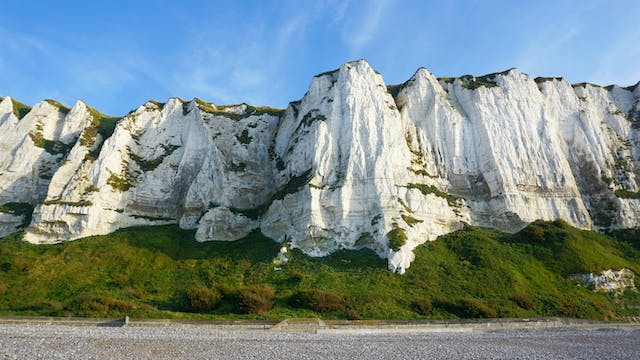
When did Britain become an island? It was connected to continental Europe by a land bridge that was destroyed 450,000 years ago. Some of the land bridge returned and that was submerged under the sea in about 6100 BC.
If sea levels were a little lower than they are now, a lot more land would be visible. The area around New Zealand, for example, called Zealandia would be above sea and it would make New Zealand much larger. It disappeared about 23 million years ago. There are several other undersea continents like this. Sundaland, is a submerged continent that would have nearly connected Southern Asia to Australia. It disappeared under the sea about 2 million years ago. The land that joined Britain to the rest of Europe was called Doggerland and it is not unique, but it did disappear far more recently than these other landmasses.
Currently, Britain is separate from mainland Europe. At its closest point, it is 37 km away from the coast of France and France is actually visible from the UK on a good day. However, it wasn’t always like this. 950,000 years ago, Britain was joined to Europe by a land bridge from the south east corner. Tools have been found from early humans in Britain dated to this period. A trail of footprints along the mudflats of an estuary have also been find. These people could have been Homo antecessor. They probably followed woolly mammoth across from Europe and settled. The land bridge was about 250 km wide. Over the next 500 thousand years, ice started to form and sea levels dropped. Slightly more of the land bridge appeared out of the sea. Fossils of the humans from this time have been found. They were Homo heidelbergensis.
By 450,000 years ago, large parts of the northern hemisphere were covered in ice. The ice covered most of Britain, right down to the land bridge. The ice sheet was very thick and there would not have been much animal life on the ice. At the bottom of the ice sheet, an enormous glacial lake built up. It was on the east side of Britain and on the northern side of the land bridge. This glacial lake was where the North Sea is now and it was trapped at the top by the ice sheets and at the bottom by the land bridge. The lake was fed by water from the river Thames and the Reine, along with meltwater from the ice sheets. More and more water entered the lake until something had to give. And it gave in style. The southern side of the lake collapsed and water rushed out of the lake. One million cubic meters of water a second flowed out of the lake and sheared straight through the land bridge, severing Britain from Europe. The flood was so powerful it reversed the direction of the Thames River and gouged a ten kilometer wide, 50 meter deep trench into the bottom of the English channel.
The ice sheets slowly retreated as the ice age ended, but the land bridge was gone and early humans couldn’t return to Britain because they had no way to cross the sea. There is no evidence of human life on Britain for about 100,000 years after the flood.
Over time, smaller ice ages came and with each ice age the sea level dropped a little, revealing part of the land bridge again. Early humans were able to cross back into Britain and they came and went as the climate changed. Then, about 60,000 years ago, another ice age froze so much water that the sea levels dropped and Britain became connected to the mainland of Europe by a huge expanse of land. There were gigantic grass covered plains where the North Sea is today, and these planes were inhabited by tribes of hunter-gatherers. This land persisted until the ice melted and the sea levels began to rise again. The rising sea slowly flooded the low lying land and forced the settlers off. Finally, there was only the land bridge between south east Britain and France left.
The land bridge was finally destroyed for good (at least for now) in about 6100 BC. The theory is that the land bridge was submerged by a gigantic tsunami. This was caused by the Storegga Slide. Storegga is in Norway and in 6100 BC, 290 km of the coastal shelf off the coast of Norway collapsed into the sea. This created a tsunami that was probably over 10 meters high and travelling so fast that it pushed over 50 km ashore when it hit Britain. This tsunami was responsible for destroying the last of the land bridge that connected Britain to Europe and for making Britain an island. This only happened 8000 years ago. And this is what I learned today.
Photo by Bernd Feurich: https://www.pexels.com/photo/white-cliffs-of-dover-in-england-9692909/
Sources
https://www.nhm.ac.uk/discover/the-making-of-an-island.html
https://www.bbc.com/news/magazine-12244964
https://en.wikipedia.org/wiki/Storegga_Slide
https://en.wikipedia.org/wiki/Doggerland
https://education.nationalgeographic.org/resource/doggerland/
https://www.nhm.ac.uk/discover/first-britons.html
https://www.explorethepast.co.uk/2018/11/how-many-ice-ages/
